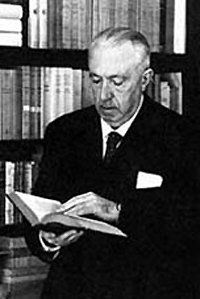
Grazia Maria Cosima Damiana Deledda was an Italian writer who received the Nobel Prize for Literature in 1926 "for her idealistically inspired writings which with plastic clarity picture the life on her native island [i.e. Sardinia] and with depth and sympathy deal with human problems in general". She was the first Italian woman to receive the prize, and only the second woman in general after Selma Lagerlöf was awarded hers in 1909.

General Gabriele D'Annunzio, Prince of Montenevoso, sometimes written d'Annunzio as he used to sign himself, was an Italian poet, playwright, orator, journalist, aristocrat, and Royal Italian Army officer during World War I. He occupied a prominent place in Italian literature from 1889 to 1910 and in its political life from 1914 to 1924. He was often referred to by the epithets il Vate and il Profeta.

Leonardo Sciascia was an Italian writer, novelist, essayist, playwright, and politician. Some of his works have been made into films, including Porte Aperte, Cadaveri Eccellenti, Todo Modo and Il giorno della civetta. He is one of the greatest literary figures in the European literature of the 20th century.

Emilio Salgari was an Italian writer of action adventure swashbucklers and a pioneer of science fiction.

Carlo Emilio Gadda was an Italian writer and poet. He belongs to the tradition of the language innovators, writers who played with the somewhat stiff standard pre-war Italian language, and added elements of dialects, technical jargon and wordplay.

In works of art, the adjective macabre means "having the quality of having a grim or ghastly atmosphere". The macabre works to emphasize the details and symbols of death. The term also refers to works particularly gruesome in nature.

Zarathustra is the debut studio album by Italian band Museo Rosenbach released in 1973. It is generally regarded as one of the best Italian progressive rock works of all time.

D'Annunzio University is a public research university located in Chieti and Pescara, neighbouring cities in the region of Abruzzo, Italy. Established in 1960 as a higher education institute and named after writer and poet Gabriele D'Annunzio, it was officially recognised as an independent university in 1965 by Minister Luigi Gui.

Giuseppe Antonio Borgese was an Italian writer, journalist, literary critic, Germanist, poet, playwright and academic naturalized American.
Giorgio Bàrberi Squarotti was an Italian academic, literary critic and poet. He taught at the University of Turin from 1967 until his death in 2017. He was considered to be one of the most important literary critics of his time.

Massimo Bontempelli was an Italian poet, playwright, novelist and composer. He was influential in developing and promoting the literary styles known as magical realism and lombard line.

The trabucco, known in some southern dialects as trabocco or travocc, is an ancient fishing machine typical of the Adriatic shores of Abruzzo — famously dubbed the Costa dei Trabocchi and the Gargano coast, where they are preserved as historical monuments within the Gargano National Park. These distinctive structures are prevalent along the southern Adriatic coastline, particularly in the Italian provinces of Chieti, Campobasso, and Foggia. Trabucchi can also be found on select parts of the southern Tyrrhenian Sea coast.

Paolo Alatri was an Italian historian and Marxist politician.

Il trionfo della morte is a novel by Gabriele D'Annunzio. It belongs to the cycle "The Romances of the Rose".
Triumph of Death may refer to:

The Trabocchi Coast, which corresponds to the coastal stretch Adriatic of province of Chieti (Abruzzo), is a 70-kilometer coast from Ortona to San Salvo, in Italy. It comprises a number of coves and reefs below the hills that end at the Adriatic Sea marked by the spread of Trabucco – fishing machines on piles. Many of the towns on the Coast maintain their own characteristics and traditions.
The Flame is a 1900 novel by the Italian writer Gabriele D'Annunzio. It is set in 1883 Venice and tells the story of a young artist and his mistress, a famous but quickly aging actress. The story was inspired by D'Annunzio's relationship with the actress Eleonora Duse. The novel contains expositions of many of D'Annunzio's theories about drama, largely inspired by Friedrich Nietzsche and Richard Wagner.

Irrationalism is a philosophical movement that emerged in the early 19th century, emphasizing the non-rational dimension of human life. As they reject logic, irrationalists argue that instinct and feelings are superior to reason in the research of knowledge. The term has often been used as a pejorative designation of criticisms against rationalism as a whole.

Beatrice Monroy is an Italian writer and dramatist.

Basilio Cascella was an Italian artist, active from the late nineteenth century to the mid-twentieth century.

















